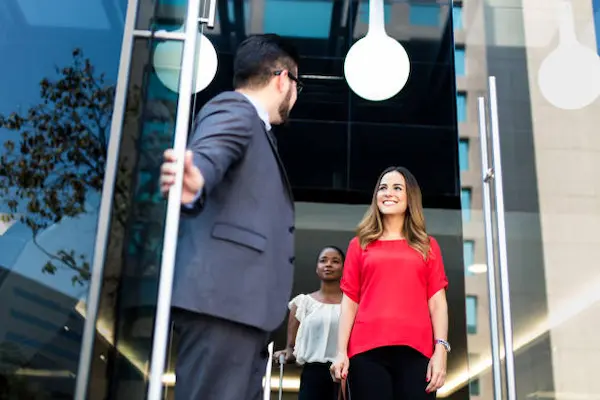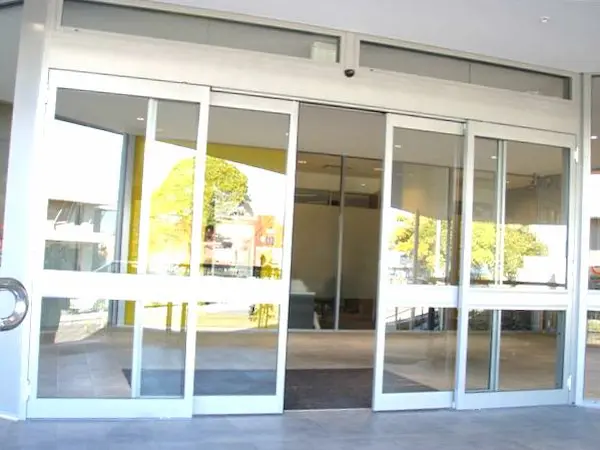When people think of a business, the first thing they often see isn’t a logo or a product, but the entrance. Entrances create the first impression, showing how a company values design, accessibility, and professionalism. A clean, safe, and well-designed entrance can make customers feel welcome even before they step inside. Whether it’s a large corporate building, a cozy cafe, or a busy warehouse, the right entrance helps create a lasting impression that reflects the company’s identity.

Why Business Entrances Matter
Business entrances are more than just doors; they are the gateways that connect the outside world to the heart of an organization. They influence how customers, employees, and visitors perceive a brand. A well-designed business entrance not only provides security and accessibility but also expresses the company’s personality.
When customers arrive, the entrance speaks before anyone does. A modern and clean design shows care, while a poorly maintained or outdated one might give the impression of neglect. Business entrances also play a practical role in daily operations — they regulate the flow of people, ensure safety, and even impact energy consumption by controlling how much air or heat escapes.
Moreover, business entrances can serve as a marketing tool. For example, glass entrances can showcase products, while solid, secure entrances may communicate strength and reliability. In today’s competitive market, details like this matter. Every business, whether a retail store or a corporate headquarters, must see its entrance as a vital part of its identity — a place where design meets function.
Main Types of Business Entrances
There are many types of business entrances, each suited to specific needs, spaces, and industries. From the elegance of glass doors to the practicality of industrial access systems, every type has its own benefits.
Sliding Glass Doors
Sliding glass doors are a favorite for businesses that want transparency, modern design, and convenience. You often see them in offices, malls, and healthcare facilities because they open automatically and allow easy entry for everyone, including people with disabilities.
These business entrances provide an open and welcoming feel, letting natural light enter and saving energy during the day. They also reduce the need for physical contact, improving hygiene — something increasingly valued in post-pandemic environments. Besides their practical use, sliding glass doors visually connect indoor and outdoor areas, creating a sense of openness and trust.
Revolving Doors
Revolving doors are often found in places with heavy foot traffic like hotels, airports, and corporate buildings. They help manage large crowds while maintaining indoor temperature, making them highly energy-efficient. These business entrances minimize the loss of air conditioning or heating, helping companies reduce costs.
They also add sophistication. The slow, circular movement makes every entrance feel elegant and grand. Beyond the aesthetics, revolving doors are practical and secure — they allow constant movement without congestion. For businesses that care about both image and functionality, this type of business entrance represents the perfect balance.
Industrial Entry Systems
Industrial entry systems are the workhorses of business entrances. Found in warehouses, factories, and logistics centers, these doors are built for durability, security, and efficiency. They are designed to handle large volumes of vehicles and heavy machinery while keeping valuable assets safe.
What makes them stand out is their combination of strength and automation. Many industrial entrances can be controlled remotely or equipped with motion sensors to streamline operations. They also help optimize space, since they open vertically or fold efficiently. Businesses that rely on quick loading and unloading processes benefit immensely from these robust entrance systems.
Swing Doors
Swing doors are timeless and practical. They are perfect for smaller shops, offices, or restaurants that don’t need complex automation. Their design is simple yet effective, allowing easy access in tight spaces. They can be made of glass, metal, or wood, depending on the brand’s aesthetic.
These business entrances can be single or double doors, and they offer flexibility in terms of style and function. For instance, a café might use wooden swing doors for warmth and charm, while an office may prefer minimalist glass designs. In every case, swing doors combine tradition with simplicity, offering a cost-effective yet elegant entrance solution.
Folding and Bi-Fold Doors
Folding or bi-fold doors are increasingly popular in modern architecture. They are ideal for businesses that want flexible spaces — like restaurants, event venues, or showrooms. When fully opened, they merge indoor and outdoor areas, creating an open and inviting environment.
These business entrances also make spaces feel larger and brighter. Their versatility allows for customization: they can be made of glass for elegance, aluminum for strength, or composite materials for insulation. Beyond functionality, they symbolize innovation, giving a contemporary feel to any space that values both aesthetics and practicality.

Key Factors to Consider When Choosing a Business Entrance
Choosing the right business entrance requires careful thought. It’s not only about how it looks but how it performs, protects, and represents the company. Below are the key aspects every business owner should evaluate.
Functionality and Traffic Flow
The first thing to consider is how often people or vehicles use the entrance. A warehouse might need wide, automated doors for trucks, while an office requires smooth pedestrian flow. Understanding your daily traffic helps you pick the right system — one that’s durable, convenient, and reliable.
A good business entrance must handle heavy use without compromising safety. It should also provide easy access for people with disabilities and adapt to peak times without causing congestion. In short, the functionality of your entrance directly impacts your business’s efficiency and customer satisfaction.
Safety and Durability
Safety is non-negotiable. Business entrances must protect employees, visitors, and assets. That means choosing materials like reinforced steel, tempered glass, or aluminum that can resist weather, wear, and potential impact. Automated entrances should also include emergency systems to ensure quick exits when necessary.
Durability goes hand in hand with safety. A long-lasting entrance reduces maintenance costs and minimizes downtime. Whether you manage a busy retail store or an industrial site, investing in durable entrances is an investment in reliability and peace of mind.
Design and Brand Identity
The design of a business entrance communicates what a company stands for. A tech company might prefer sleek, automatic glass entrances that express innovation, while a luxury store could opt for elegant wood and metal finishes that evoke exclusivity.
Colors, materials, and lighting all contribute to this message. Think of your business entrance as part of your visual branding. It tells your story before customers even speak to your staff. Matching the entrance design with your overall brand identity creates harmony and reinforces customer trust.
Energy Efficiency
Energy efficiency is now a key factor in modern construction. Business entrances can play a big role in saving energy — especially automatic ones that close tightly to prevent heat loss or air leaks. Insulated materials also help maintain interior temperatures, reducing the strain on HVAC systems.
Besides saving money, energy-efficient entrances demonstrate environmental responsibility. Customers increasingly value sustainability, so choosing efficient designs not only lowers bills but also strengthens your brand’s image as a responsible and forward-thinking company.

Smart Innovations in Business Entrances
Technology is reshaping how businesses think about entrances. Smart business entrances now include sensors, touchless entry systems, and connected control panels. These innovations boost security, hygiene, and convenience.
Motion sensors open doors automatically, reducing physical contact and ensuring smooth entry even during rush hours. Touchless systems, like facial recognition or keycard access, enhance security while making operations faster. Some companies are even integrating mobile apps that let managers monitor entrances remotely and track usage data.
These modern solutions combine safety and innovation. In high-traffic environments, they help reduce accidents, prevent unauthorized access, and improve customer flow. As technology continues to advance, smart entrances will become a standard — blending design and intelligence in every doorway.
Conclusion: The First Impression That Lasts
Your business entrance is the silent greeter of your company — the detail that speaks before you do. A well-designed and efficient entrance reflects professionalism, care, and modernity. Whether you manage a small shop or a large corporation, investing in the right business entrance enhances comfort, safety, and brand image. Remember, people may forget what they saw inside, but they will always remember how they felt when they first walked through your doors.
